Berlin Journey/Journal
*(scroll to the bottom to see most recent post)* The Memory Void is closed
Three generations ago my dad’s family lived loved and lost many things in this city, in September 2022 I returned, to find the missing.
Here I continue my creative journey exploring my family’s history with the city, as I delve deeper into my own journey as a German Jewish descendent, both past and present, alongside its culture of memory.
September 2022

What follows are excerpts from my journal and camera: my visual abstract thoughts and feelings
Berlin bound...sleepy, overwhelmed...we leap forward.
First I dive straight into the Sachsenhausen memorial’s meeting of 2nd, 3rd and 4th generation descendants of survivors of Sachsenhausen concentration camp, called the ‘the most beautiful concentration camp’. This is the second year we have met, and I find this time the memorial, its sights of power, of destruction, of triangulations, less completely unbearable, perhaps this time I have weathered more storms, am I feeling the emotions more? Or repressing them? Either way this strange motley crew of descendants from different parts of the world have a special place in my heart, we have laughed together and cried together.
(Some film from my time last year)
Its funny in some ways that Sachsenhausen, where my great grandad Bruno was held for two weeks after Kristallnacht, was one of the lucky tales of my family, he was released and escaped with my great grandmother Irma, to South Africa, many others in my family were no so lucky...
More recent drawings:
The ‘iconic’ sight of the camp, the memorial tower to the political prisoners. For partisans, resistance fighters were the heroes, my family, were just victims...
Closeup outline of the GDR memorial to the fallen communists, here I paraphrase a discussion I had with one of the descendants, also an academic in frankfurt, who summed up the German sentiment as ‘experts in forbidding and forgetting’
Never have I felt more closely the connection to my angels, in Berlin where like timeless beings in a 30-second walk you can stroll past 200 years of history: Walk and look up and like any big city gawk at the neoliberal investments tower above you in their sparking Rand-esque grandeur, look ahead of you, to face fragments of the Berlin wall, remnants of a divided past, look closely and you still can see bullet holes in many old buildings, then look down and you can see the variably traumatising for any living jew and commemorative for the dead jew, the stolpersteins, continue this walk and you may walk past GDR era communist architectural splendour, 1920s joyful art deco and finishing off before you turn the corner I spot some angels drawn on the doors of an old Gothic church.
What have they seen?
22nd September
Is it right to laugh in the Jewish museum? Should commemoration be only pain suffering, sadness, and deep quiet reflection?
The Berlin Museum seems to spend so much time trying to explain to the german public what Jews are, and that they are not defined by the holocaust, whilst at the same time leaving all viewers with the constant that Jewish assimilation failed and therefore Zionism is the only option.
Following signs to the memory void- only to find it closed.
It is fucking funny, ‘the memory void is closed today’ but the commemoration here is terribly sad... September 23rd
The layout of the Jewish museum reminds me of the triangles of power in concentration camps, scars across a landscape and across memory. 24th September

This blog is starting to feel too depressing
Here are some pictures of Berlin in the Summer, ...when I cycled round the city in a borrowed bike, but somehow through the act of cycling I felt more at home in the city, getting a greater sense of its grided landscape...through movement tracing and retracing....reminds me of an old poem I was once given about how bicycles are weapons of anarchist resistance, self-propelled weapons of movement.
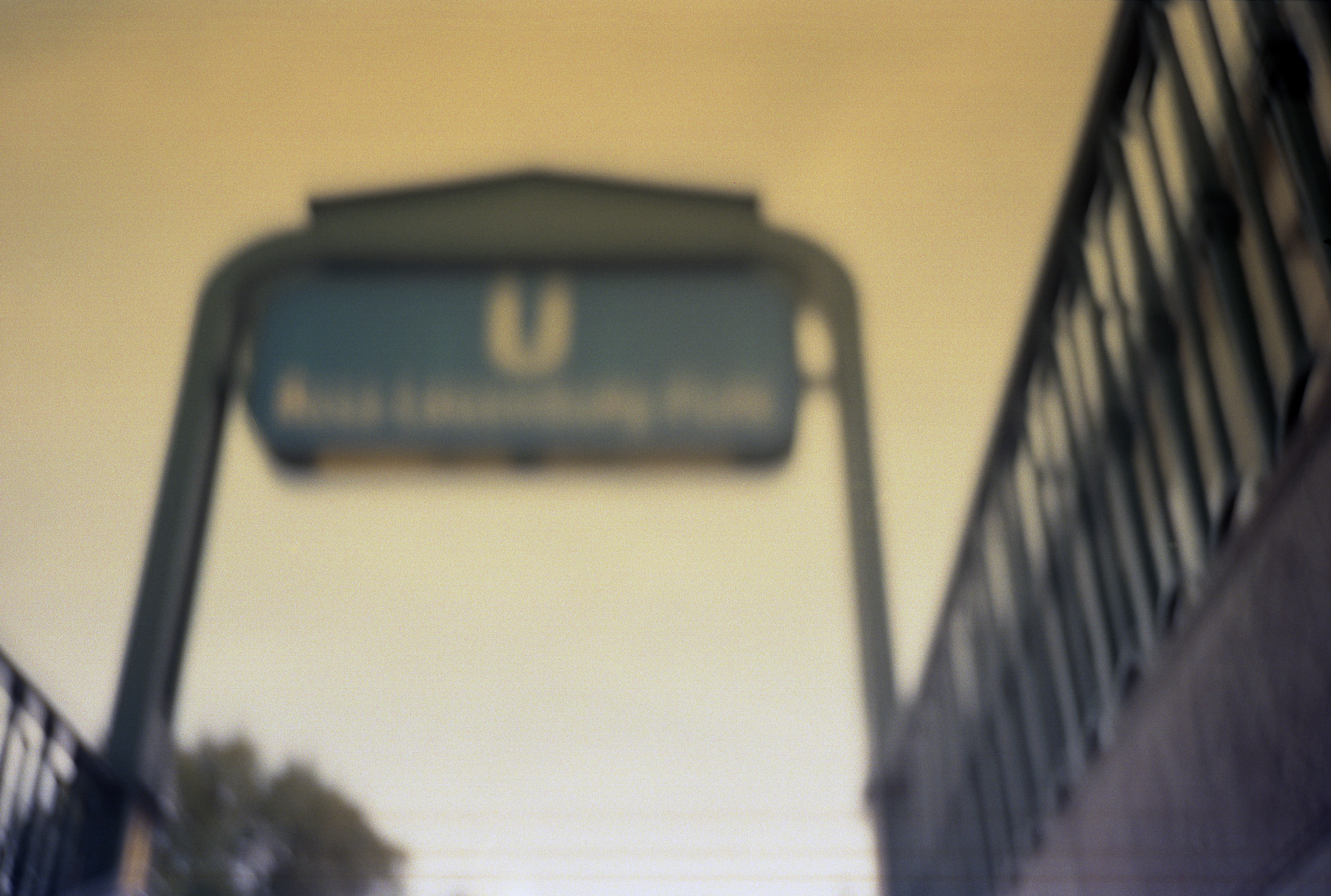
The blurs here, are purposeful in the sense that being in Berlin, in Germany with the loss of the language my family once spoke feels like I am looking at the world without my glasses, visible, workable but not quite there, not quite real.
28th September.

This is my favourite memorial at the moment. Memorial to the Rosenstrasse protest, one of the most successful nonviolent acts of the war. In 1943 6000 non-Jewish women protested their Jewish husband’s arrest in Berlin. Due to the very public nature and size of their protest, Goebbels ordered the husband’s release. One of these men was the brother of my great-grandmother. 30th Sep

2nd October- I’ve now been here a few weeks and although feeling overwhelmed/excited by ideas, also grappling with the difference in my last two cities, going from London, the city I was born and grew up in, with a large social circle of peers and comrades to bounce ideas and arguments off, compared to my new life in Berlin, a much more solitary self-motivated existence... just me myself and the history.

Drawing of a memorial around the corner from the one above, commemorating and drawing parallels between the 1830 uprisings and the 1989 protests.

3rd October- Jewish museum is...
Not for me, or at least not for German Jewish victims of the holocaust, beyond strangely patronising sections explaining in painstaking form what Jews are to the public (although more worryingly is the fact that maybe it’s needed?) I get that same dislocating disassociated feeling of being the studied, the written about the post-post.
Statistics statistics statistics about Jews, is it informing educating helping or reducing us to number after number, nameless statistics of 6 million dead and not many alive
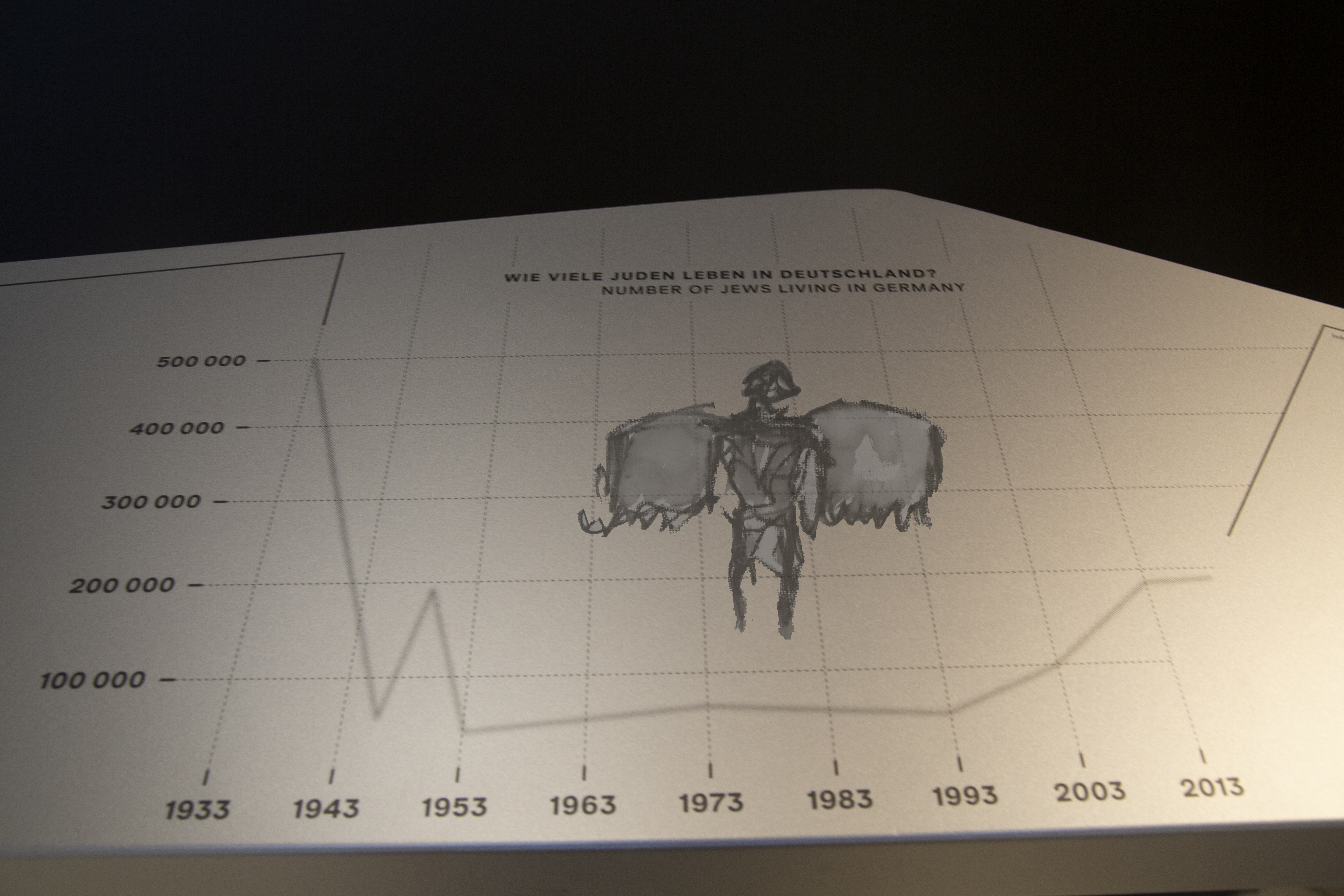
Its somewhat comforting that the boxes and boxes of restitution files from our cousin Bruno, that took three generations of his family to regain their lost house, is no unusual story, facing photos of file after file of restitution, made us feel like we were all part of the similar futile battle to get back what will forever be lost. The fact they acknowledge the bureaucratic hell that descendants went through is important, valuable in fact (although not as valuable as the wealth lost) but they also don’t seem to suggest anything else to move forward...again this all feels stuck in time, very much a museum not a space of the living.
I’m still shocked at how the constant of the exhibition, seems to be the not so subtle message that assimilation failed and that therefore `Zionism is the only answer, Jews going to Israel is inevitable. Fuck that I feel celebrate difference, diversity and diasporas!
Dislocation of being the subject in a museum
It’s about you
but against you
The journey continues...New developments.
8th October: Stolperstein ceremony- In west Berlin’s leafy suburbs, an unusual haunt for my Berlin trip so far, attending a stolperstein ceremony organised by a South African Jewish Berliner friend of mine, not for his family but friends of his. Almost all of them escaped, apart from one who took his own life in 1938, like Benjamin and many others, sometimes it seemed the only way out.
Although I have had many conversations critiquing the Stolpersteins, the fact they are made by a German. not a Jew, the fact you can often not notice them, and how in some ways it feels like it spreads traumatic scars across a city for living Jews, reminders that you could be next...perhaps it was the early morning ceremony and my lack of coffee... but I was completely taken aback by the ceremony. Instead of my questions, queries and challenges, I was lost for words.
It was something about the sheer physicality of his action, the sheer act of atonement of putting words into stone, brick and mortar sweat and tears of the many thousands this now old man has done. By him tenderly placing those words in the very floor where we walk, it becomes a constant reminder of what has gone and what should never return.
12th October- Exhibitions, art. Modernism catastrophe -
Visiting the modernist art exhibition in the Berlin art Gallery was astounded by the work created in the interwar period, and the mass break that the second world war caused, the loss of so many artists and creatives...I’m reminded of a (not factually correct) Robbie Williams joke: “I was at a German talk show once (and they asked) "Why do you think there isn't so much comedy in Germany?" And I said: "Did you ever think you killed all the funny people?".
Such emotional ground-breaking art.
My own reflection of a piece.
Do I, could I draw my family like this? the decrepit decay of history upon them.
Also really interesting to see the impact of the first world war on art as well, as for my family sometimes as traumatic as the second world war, although perhaps not the same way for the national consciousness.
Another art exhibition questions how exhibitions or collections that were once colonial, can they ever be liberated or removed from that context, in the same way, do institutions and places with Nazi holocaust complicity, are they able to escape the same fate? Do institutions and structures of power that allowed a thing to happen, ever have the potential to stop that? Germany still operates under the same Penal codes that the nazis did.
303 Memorials in Berlin. Do I visit them all?
Saw a strange film at the resistance art exhibition. About nuns who work in Dachau, in many ways seems like the ultimate act of penance, work where the darkest most devilish days of humanity occurred, also seems like the start of a pulp horror about deamon worshipping nazi nuns. What is revealed at the end of the film is the fact that the nuns started working at Dachau during the holocaust, which changes it from an act of penance to collaboration? Complicity? It at least emphasises the almost fetishised nature of Jewish trauma and loss in the relation to the holocaust, and a stark reminder of the contentious topic of ‘Hitler’s pope’ Complicity, complacency, those who claim to be the most pious, often end up being pigshit.
16th October
Continuing to draw memorials. Murals, sights- like the old Airport pictured below.New developments in my work- memorials, monuments, myself:
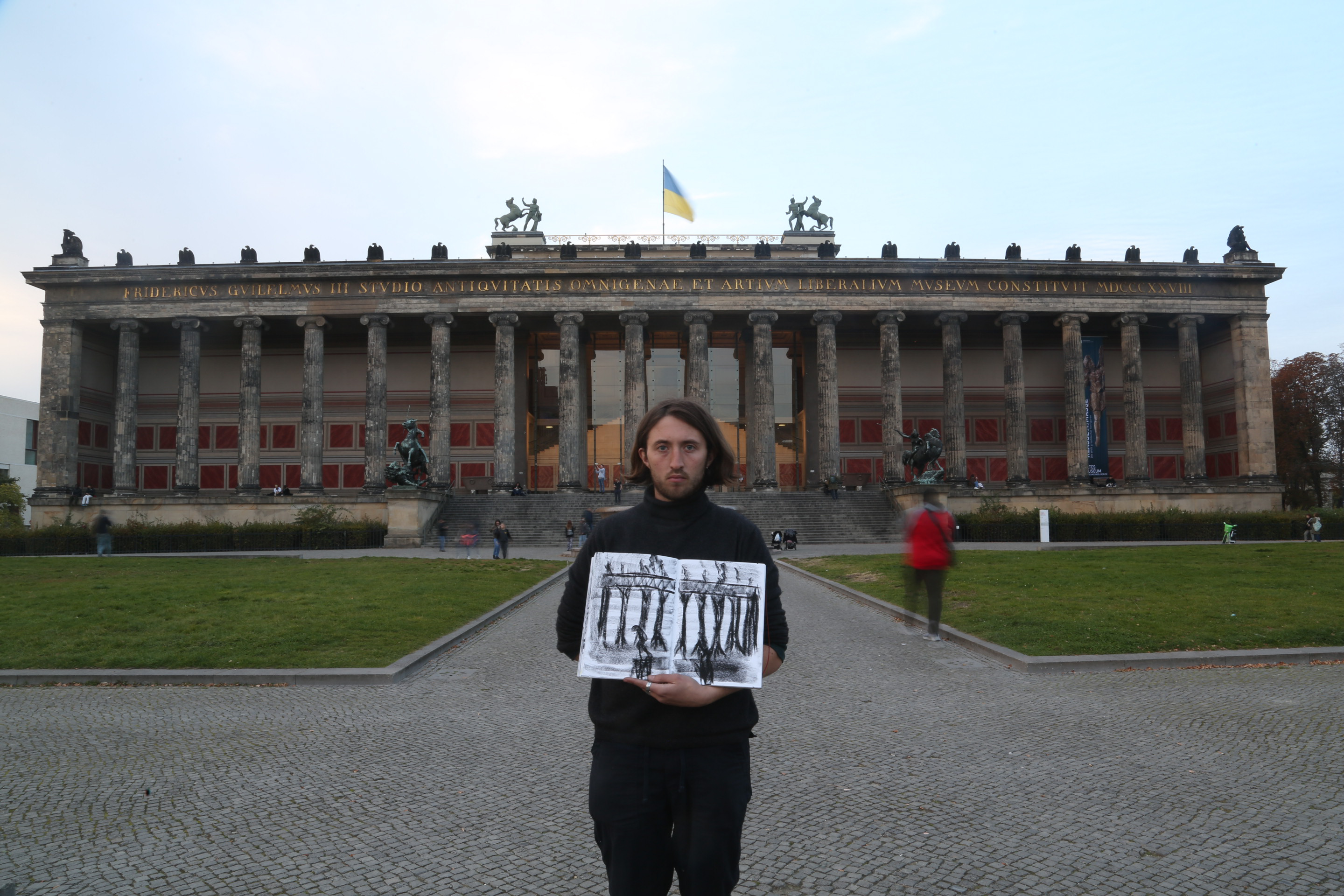
Reflections upon my family’s dislocation, my still being here and returning, the fetishisation, the commercialisation of the traumatic history of berlin into ‘20 monuments and memorials you must visit before your time is up’ I am reflecting the refractions of history on these places, where race riots, revolutions, and warfare has ripped through these places, ended up neoliberal tourist spots to visit before or after your starbucks and currywurst. I am here in my art as a reflection of my feeling my emotion is here to disrupt the stillness of these images as the people move past.
17th October: meeting strangers
Two interactions I’ve had this week at two different memorials:
Security walk up to me as I set my photo up in the depth of the memorial to the murdered Jews
‘Are you making a sign?’
‘No I’m making art, you see this memorial is for my family’
‘Your family?’
‘You see I’m Jewish’
‘Oh I see sir carry on don’t worry you can make a picture’
‘Thank you’
‘We just worry sometimes people try to make a sign for protest’
But he was right, it was a sign of protest.
‘Are you making a sign?’
‘No I’m making art, you see this memorial is for my family’
‘Your family?’
‘You see I’m Jewish’
‘Oh I see sir carry on don’t worry you can make a picture’
‘Thank you’
‘We just worry sometimes people try to make a sign for protest’
But he was right, it was a sign of protest.
While I was by the Train to Life Train to Death memorial, commemorating both the kinder transport and the trains which took many Jews to their death, I had a strange conversation:
A sad man smelling of alcohol who probably lived on the streets asked me what is that?
In broken German I replied, I don’t speak german I’m sorry’ but this, pointing, is a memorial
A memorial he asked
To the Holocaust I say.
Ah he signed, then said he said he was Bulgarian, I said I was English and Jewish, and he looked at me with sad eyes, thanked me and walked off.
I’m not sure what for.
A sad man smelling of alcohol who probably lived on the streets asked me what is that?
In broken German I replied, I don’t speak german I’m sorry’ but this, pointing, is a memorial
A memorial he asked
To the Holocaust I say.
Ah he signed, then said he said he was Bulgarian, I said I was English and Jewish, and he looked at me with sad eyes, thanked me and walked off.
I’m not sure what for.
Cycling home along Franfurterstrasse, carrying today’s drawings in my basked, but as I cross Paris Commune Alle, a bump in the road causes my work to spectacularly fly off:
My art flew off my bike on the Paris commune road
Memorials to the wind
Paper to the floor.
18th I’ve been thinking a lot about my employment of Benjamin’s Angels in my work, after visiting an exhibition dedicated to his life in the suburbs of South Berlin on the weekend, sitting outside in the stately home I reflected on his thinking.
His employment of the angel’s in his theses on history, how they were a way of combining Marxism and theology, by looking at time, and our conceptions of it, is ‘weak messianism to interrupt the flow of empty homogenous capitalist time’

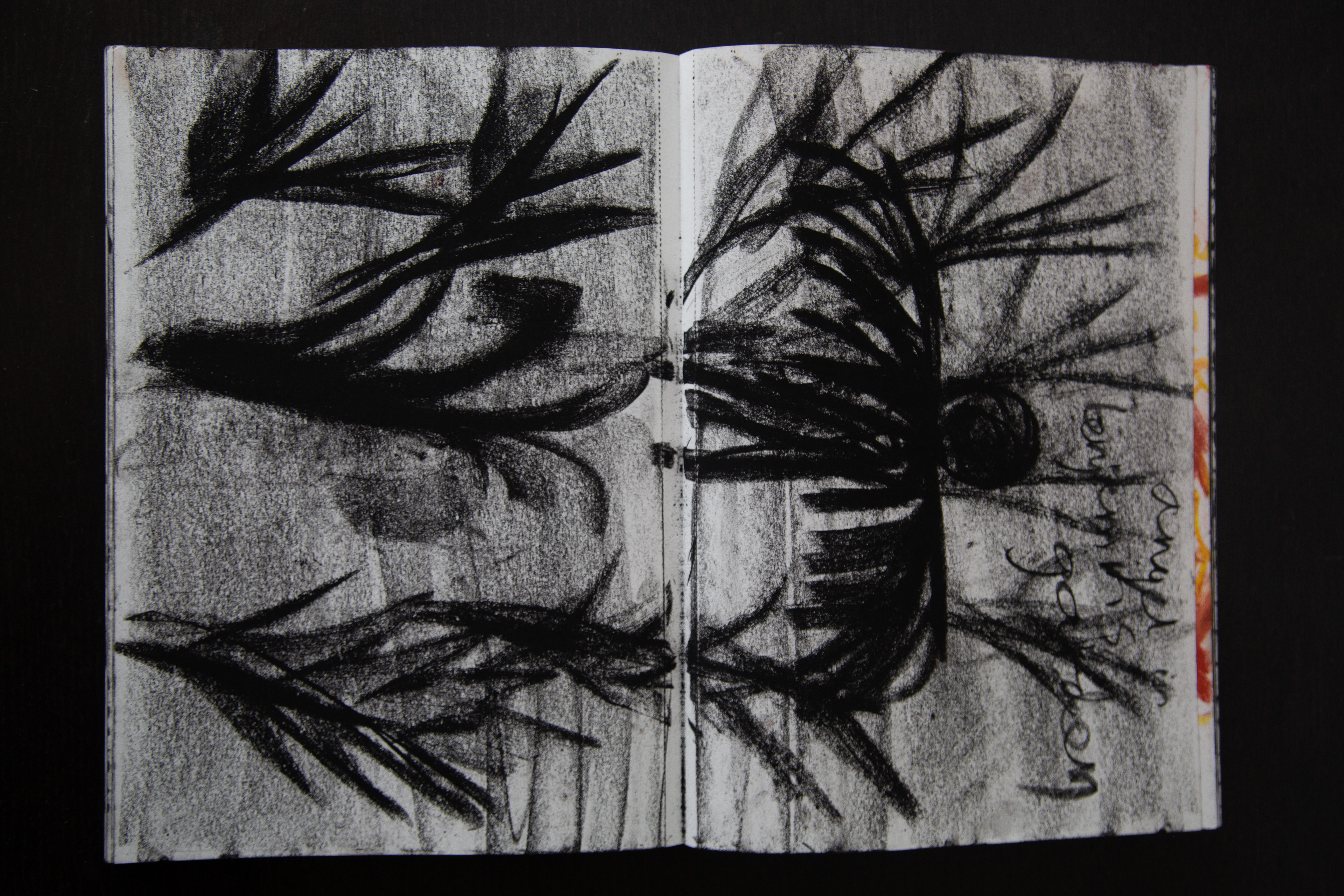
Angels in the Benjamin exhibition
‘Metaphors are the means by which the oneness of the world is practically brought about’ Ardent
‘Metaphors are the means by which the oneness of the world is practically brought about’ Ardent
How do I embody weak messianic time? The frenzied distruption?
His use of mythical beings where a way to challenge and interrupt, disrupt capitalist time, the endless suffering in the continuous march of history in the name of progress. I can’t think of a city that demonstrates this best than the one I currently reside in, Berlin. A city forged by Imperial conquest, first world war suffering, Weimar revolution and strife, Nazi terror, reconstitution and then Totalitarian rule and neoliberal impositions. Despite this it is one of the youngest if not the youngest capital cities in Europe, time disrupted, compressed and reconstituted.
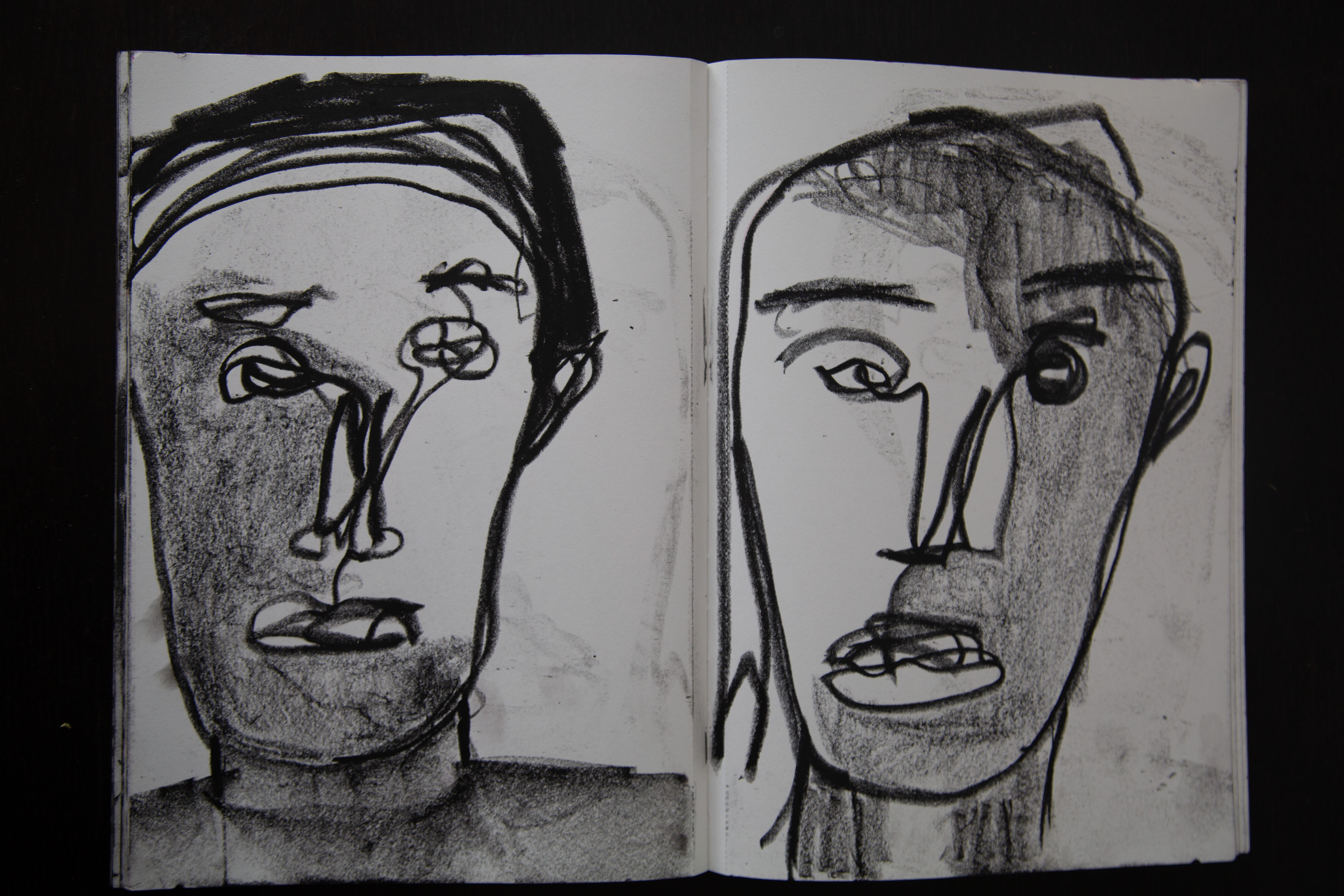
So by me being here- Am I attempting to rupture homogenous time, ceaseless suffering, by showing that the victims, the malignant remnants are still here suffering, living and laughing?
19th October- day trip to Wannsee:
(aka the site of the final solution aka the place where the Shoah was planned and processed)Arriving, after an hour’s journey from east Berlin, across the station, looking out at the lake are two startling statues, ten metres apart, on the right by some historically valued old neo-roman villa, is the national symbol of Prussia, a white imperial woman looking towards progress, and to her left, is Bismark, the power behind the throne of German imperialism, his statue with its arms cut off, just a torso and a serious and imposing head, giving him the unfortunate look of a victim of a particularly violent revolution.
What struck me about these statues, was that here is the founding figures and leading light of Prussian (and therefore German) nationalism, its symbols and leaders, who are looking across at the final solution, the logical endpoint of nationalism, violent separation of the other.

Bismark? Besmirched.

Some thoughts from the exhibition of the Wannsee conference:
*thought jotted down while inside the ornate building* Feeling overwhelmed hot dislocated and distrusted in this room, while many old German couples walk past reading silently somewhat emotionlessly.
I have been in many beautiful places and spaces where terrible things have happened.
Of course, the only objection in the meeting is to the bureaucratic nightmare that some of the proposals will cause, which must be the most german Nazi moment ever. And of course, that objection was used as justification for why that particular official was trying to prevent the holocaust. It’s no surprise that one of the people present would become the assistant to the west German chancellor.
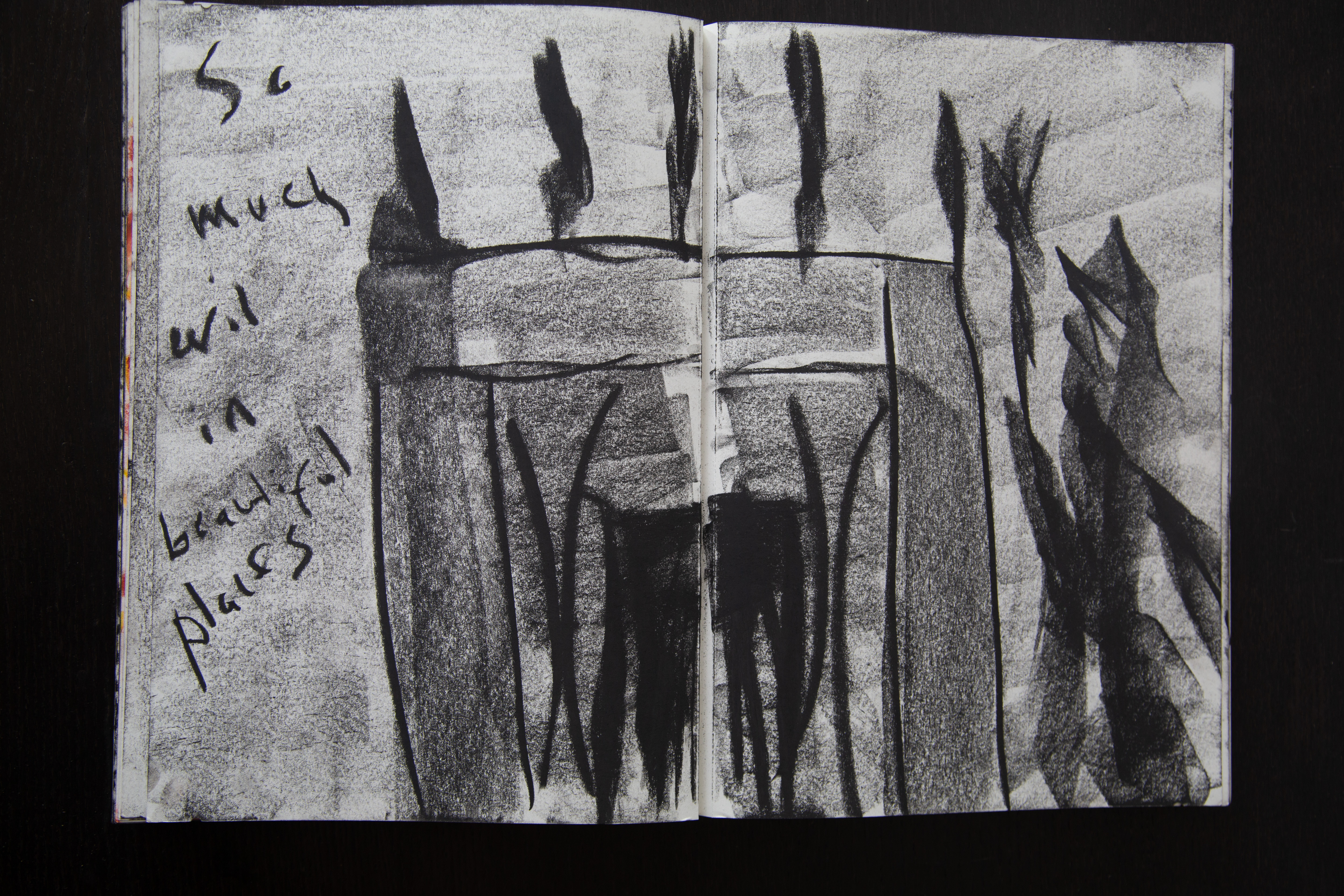
Although it is true that the East refused to admit there was any problem with nazi’s in their state, which arguably led to the rise of the far right in the east today, at least they didn’t have any actual active skulls on the uniform penchant for leather nazis in their government.
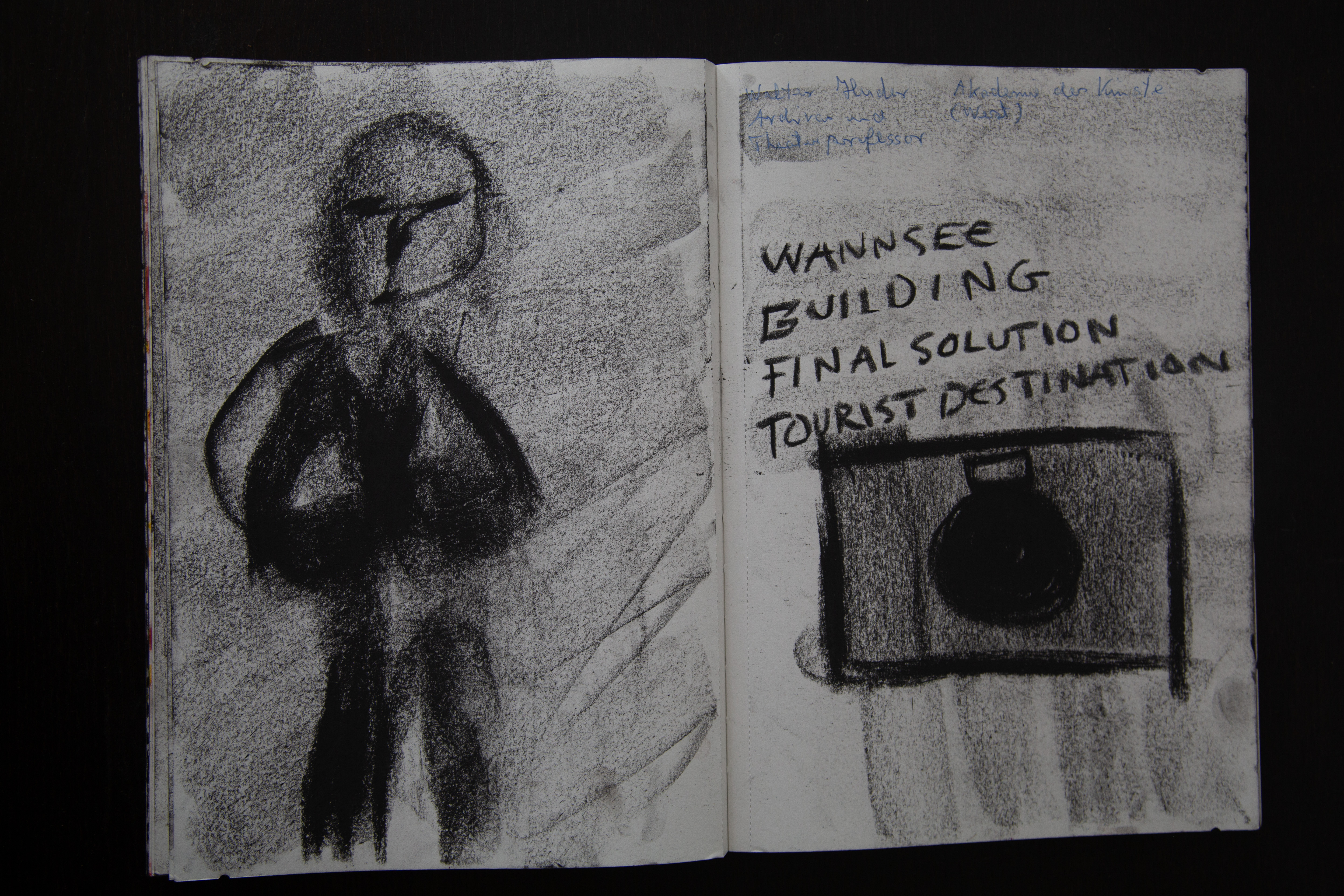
Another observation is that this was really just a meeting to work out the bureaucratic details, the decision was a given.
The practicality of moving Jews from A to B to station Z.
 Old journal drawing depicting ‘Station Z’, the name for the Ovens and gas chambers in Sachesenhausen, for it was the last stop for inmates.
Old journal drawing depicting ‘Station Z’, the name for the Ovens and gas chambers in Sachesenhausen, for it was the last stop for inmates. I got that suffocating feeling again, of being in a room where decisions were made, where the ink dried that led to my family being murdered. The decision made here led to my great-grandma being deported to the east, and many many others.

The discussion around ‘Mishlings’ (Nazi term for half Jews) is dislocating, that if I was alive in this time (being a ‘half caste’ myself, I would have been given a choice (if my politics, and partnering with an Aryan was agreeable) to either leave Germany, or stay and being ‘voluntarily’ sterilised. Not much of a fucking choice is it.
 (pictured Mendel brain)
(pictured Mendel brain) The lake is beautiful as I walk towards the sun and train station leaving Wansee and hopefully everything else behind me.
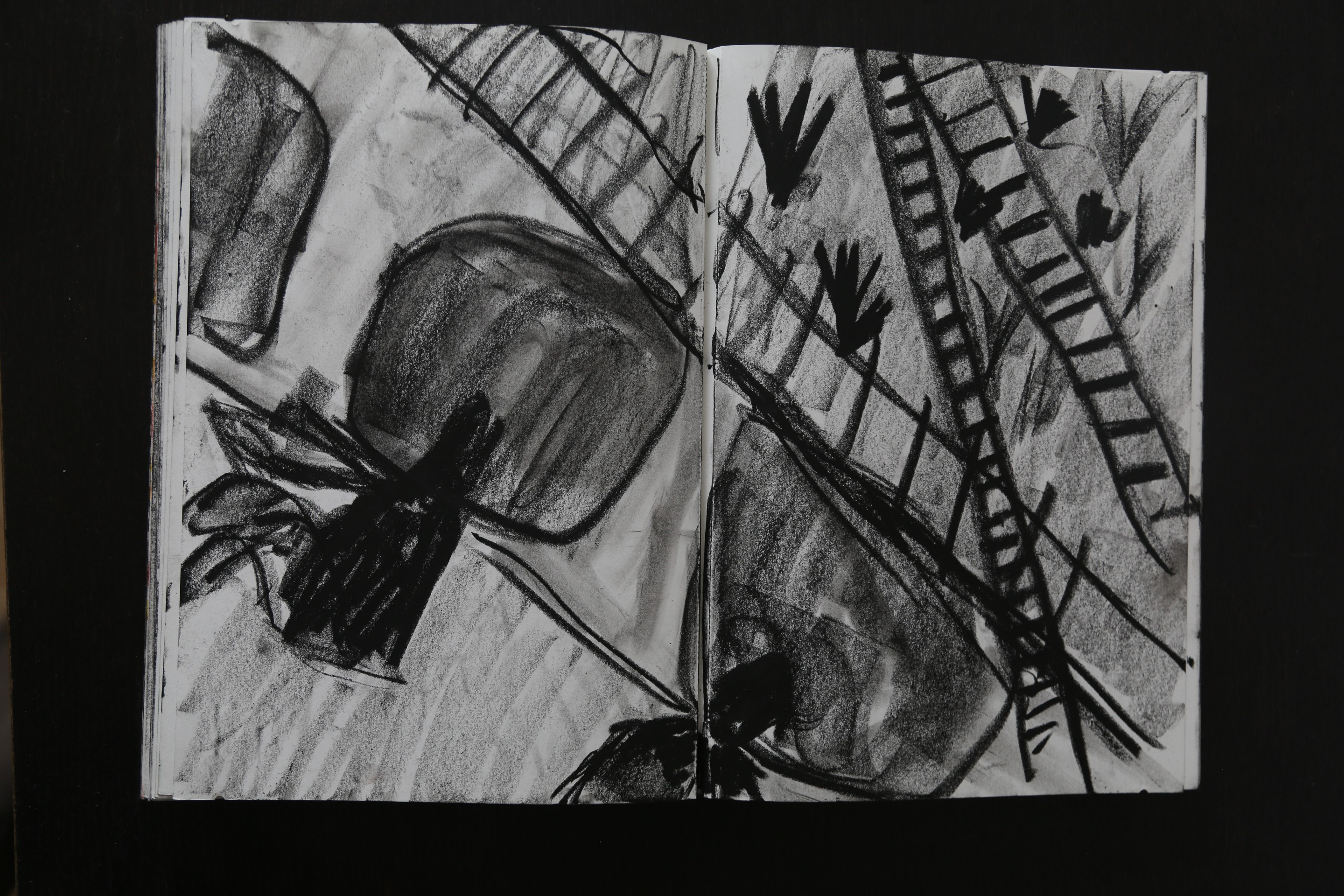
Train in Vain
Doing this, continuing to go to sights of trauma for my family, is like plunging my head into ice cold water, over and over again...
Be rugged, defiant, not despondent - sitting outside waiting for the light to change
Be rugged, defiant, not despondent - sitting outside waiting for the light to change
21st October - Memorial to the murdered Jews
Yesterday I returned to the memorial to re-photograph myself with larger paper and drawing. I was also hoping to film another interaction with the memorial’s security, unfortunately, the security remember me and do not bother me this time. So much for institutional challenges to memorial culture through guerilla art.

Angels hide in memorials - for only the grieving can see

‘It’s meant to be experienced’ - Tour guide of a memorial- arms waving, performance of history
I had a different interaction however. While standing and posing with my drawing, with screaming kids joyfully galavanting around the memorial for the murdered Jews (passing no judgement here), a woman approached me and asked what I was drawing. She said she loved it, was very kind, and told me her grandparent survived Auschwitz, they had just come from visiting another concentration camp, and she asked if mine had, I told her about Fanny my great-Grandmother who had died in the camps. But she did not understand how I could exist, exclaiming impossible! how could she be my great grandmother, I responded in mock horror, don’t deny my history! Luckily calm was kept as her companion explained that I was a young guy, and I explained that her son, my grandfather, had escaped to South Africa. We exchanged nationalities and pleasantries.
She asked to take my picture, and I her, and then she clasped my shoulder with emotion and told me to take care, weaving her way amongst the pillars.
22nd October: Tourdegrace
Thinking about victimhood- about how engaging in this work, in this holocaust history, am I falling into the trap of the oppressor oppressed?
Victimhood comes easy, resistance is much harder.
I am thick time
I attended a walking tour of Neükoln, as part of a meeting of a radical Jewish bund group (interesting conceptions of jewish identity, of radicalism in Berlin, always uplifting in equal measure to meet the activists of a new city, for we are all the same, from Manchester to London, arguments about semantics, and other activists.... But more importantly, it introduced me to the state of the nation in Berlin activism and to get a sense of how many others are tracing the footstep of memory in this layered city.

One conversation had over drinks in the evening, was about a conference they were taken by in which a particular attendee kept dismissing and arguing about memory studies and memorialising They dismissed it by questioning why on earth are we not organising for a better future instead of questioning the past. I could not but help take it to heart, for what am I if not memorialising, but am I also attempting to rupture time, bring the past into the present so we can organise for the future?
we went to a memorial for soldiers of the German imperial army, who had died perpetuating the Namibian genocide. Redefined as a colonial war, this memorial, with a half-arsed compromised counter-memorial next to it, questions the politics of recognition of who is allowed to mourn and who is not. Who does it serve? And how has this colonial design gone under the noses of memory practice? Which is so thought through in Berlin.
Simply sadly on one level its because the Jews have recognition, the Namibians do not...
On the same day we attended a ‘closed’ memorial, in a southern suburb up a rubble hill, which had been gated off, this World War One memorial was used to commemorate Nazi soldiers, deemed too contentious and closed off. Who decides it is and is not? When will someone decide you are not worthy of commemoration or decide that it is best to be forgotten, confined to a hill of rubble, not a hill of pilgrimage?

What is our relationship to objects? To monuments? How do we move around them, and navigate the space, are we meant to move clockwise, anti clockcwise? How do you move to rupture it?
26th October: Winter blues, lonely city, Angelic skyline.
Feeling shitty is shittier when you are in a city where you know more ghosts than the living. I’ve been following a good friends advice recently, to embrace the loneliness that this trip has become, the flaneur that I was always taken the piss out of for being. However, not feeling quite up for a holocaust memorial I decided to go see some other museums and art galleries, cycling over to the museum island. Immediately, because I can’t escape the family history, the Altes museum looms over me, the museum of the iconic family photo in the archive, I decide that I should enter. It was strange putting foot on step, after such distance, always photographing, drawing, imaging, but never actually inhabitting. Through its doors I’m goin to walk into the present, taking the past with me... But I walk out because its 10 Euros to see an exhibition on the Roman’s and Greeks.. the antiquity can stay in the past.

What came before...
Finding many of the museums on the island to be a little ‘great men, progress and elightenment history’, which does not inspire me to stomach the money for it... art should be free and the ghosts of Europe’s past really should be, and the others closed due to the recent radical act of resistance by Climate protestors throwing mash on a Monet in an art museum in Berlin (solidarity), I reverted to my family’s ontology, which is to visit a beautiful church, the Berlin Domed Cathedral. Its always been a strange dynamic of my family, their affinity for churches, despite their atheistic background.
In the Berlin Cathedral, where the imperial royal family are buried, it’s strange seeing the exaggerated gilded gold gothic imperial tombs, skulls, angels and Latin, until you reach the great nationalist unifier, Kaiser Friedrich III, and instead we are faced with marble, renaissance-esque tomb of a ‘peaceful’ sleeping war-lord. The contrast with the previous tombs is dramatic, in his hand is a sword, but he cannot fight for his son is not buried here, here is the last of his line honoured with this divine right, for revolution, war and well the 20th Century followed.
Despite the imperialism of the Cathedral, it’s hard to not feel enthralled by the beauty of the church, surprisingly Protestant despite its catholic-esque splendour. Despite the many horrifying things done in the name of god and religion, they really make a place of peace, reflection and calm in the storm of the world.
Climbing to the top of the dome, the 360-degree view of Berlin I find myself sitting with the angels. Six angels face out, one of them seemingly shredding it on an electric guitar.

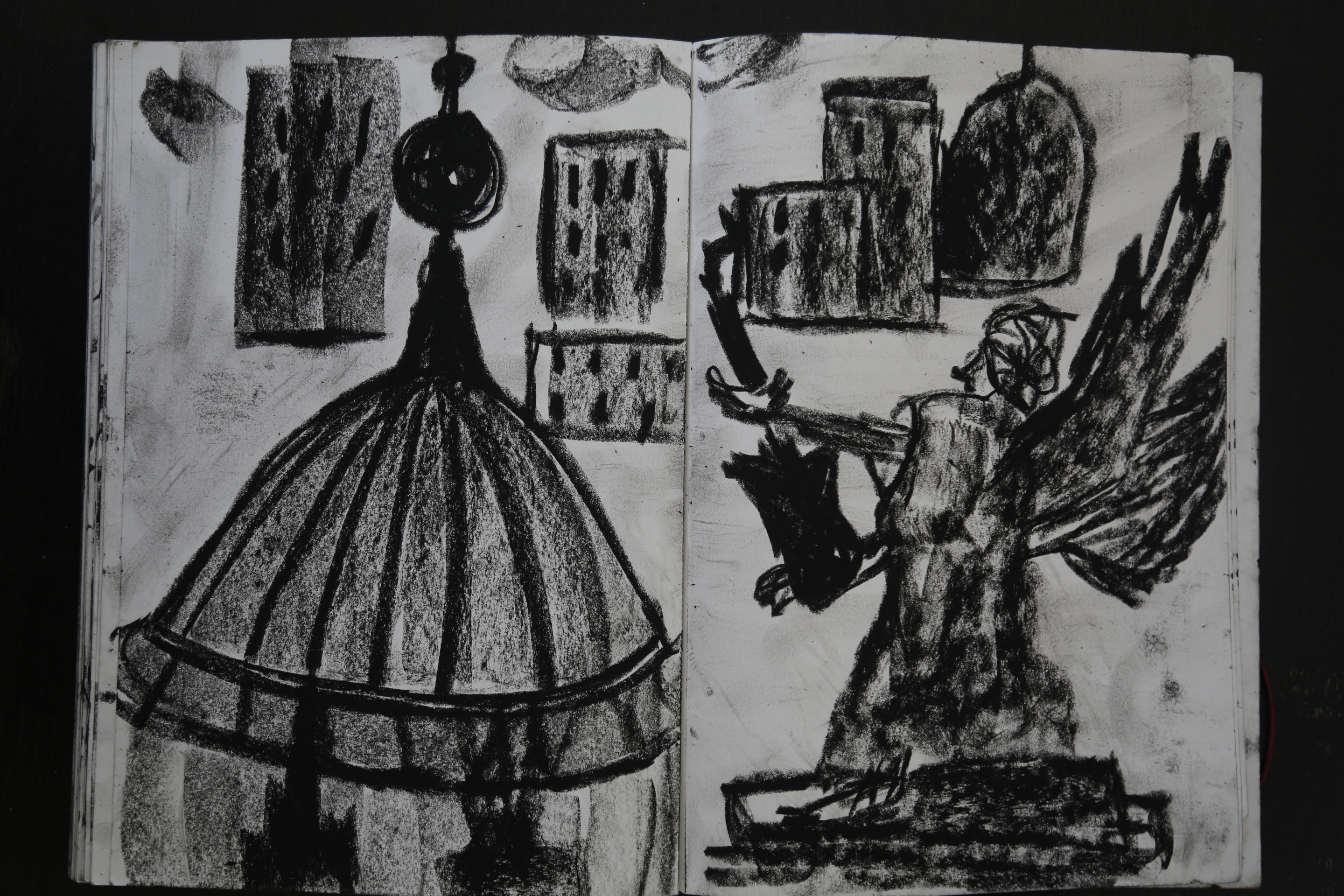
I just love how they are looking over the city, standing drawing them, one really feels like they are an angel in Wim Wenders Wings of desire


I climbed the cathedral’s panoramic view,
there I drew the Angels
carved out of Stone
Watching the city
I watched them.
Descending the spiral staircase,
amongst the grafitti and
thoughts left behind,
I drew my angels
In the stone
To watch me.
Heavy wings.
there I drew the Angels
carved out of Stone
Watching the city
I watched them.
Descending the spiral staircase,
amongst the grafitti and
thoughts left behind,
I drew my angels
In the stone
To watch me.
Heavy wings.
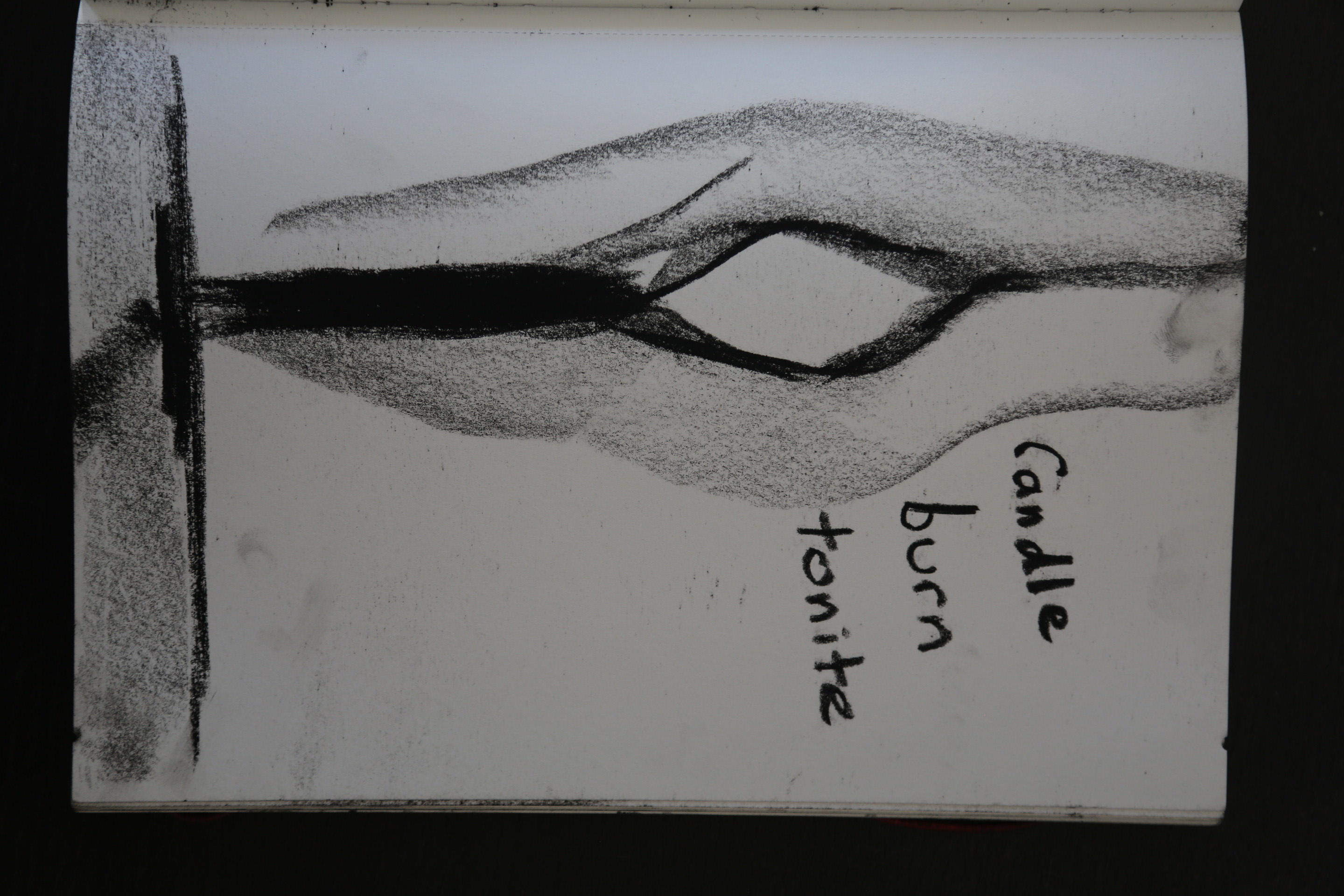
I will return to the cathedral to photograph my new public art...
Churches make me feel peaceful, they remind me of my delightful dearly departed grandmother, in her enthusiasm and lust for life, wide eyes exclaiming at this Norman roof or an early medieval tapestry. In moments when the day is hard, getting out of bed a struggle, thinking of her endless boundless enthusiasm for life, epitomised in her love of churches, greatly helps.
‘You can’t draw a Jewish Memorial’ 3rd November
Only the second time I’ve cried at the memorial to the murdered jews.
Both times were holocaust industry workers redefining, controlling, denying. The last time was a tour guide comparing rising antisemitism to a fucking lasagne.
This time, as I was wrapping up my work, thankfully I had taken the pictures I wanted, a security guard asked me what I was doing, I told him I was making art, he asked to see my drawing, I showed him, and he told me I was not allowed, he then spoke in German into his walky-talky and told me to follow him, I asked him why and he told me I wasn’t allowed and just to follow him.
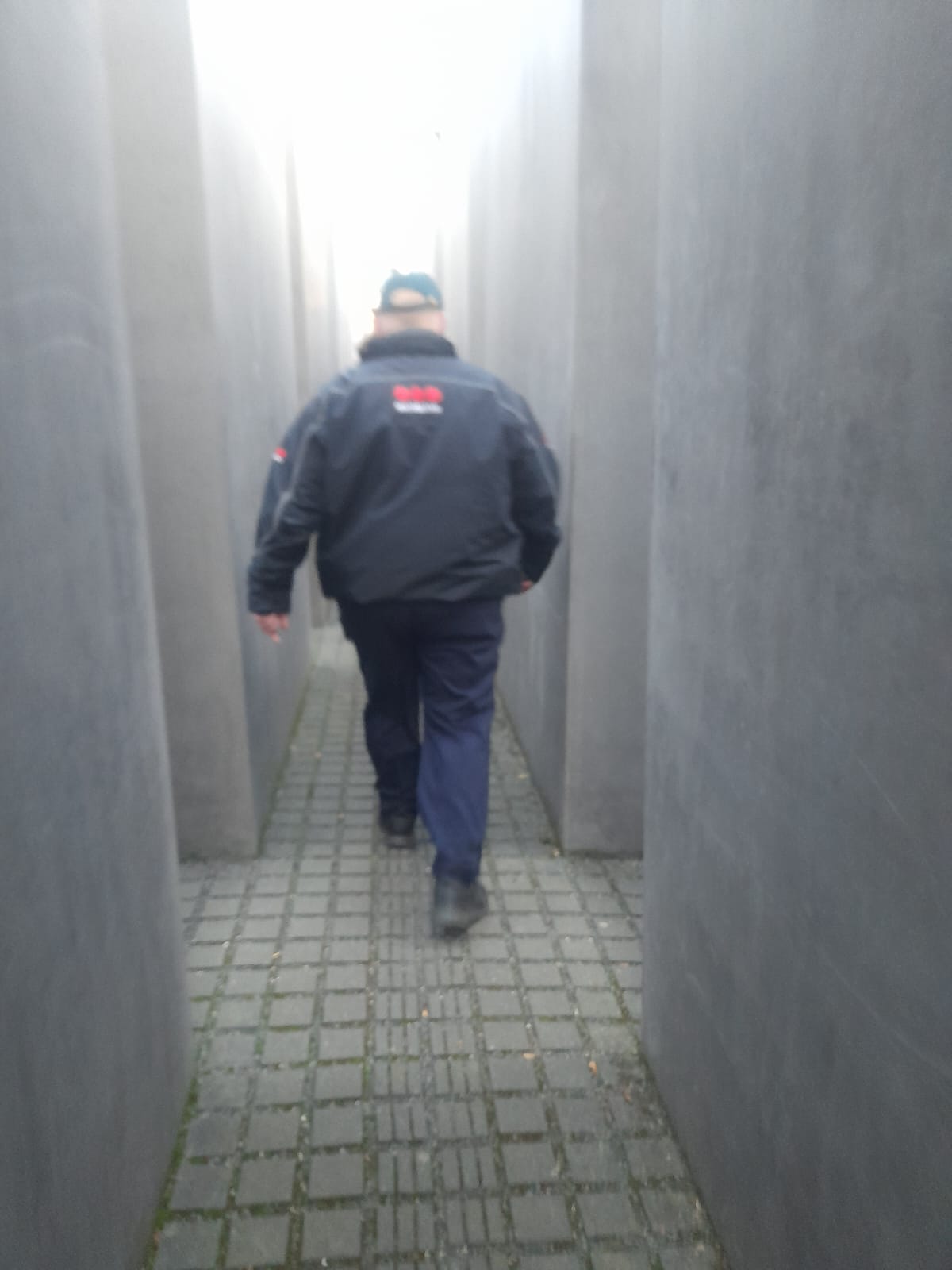 Pictured said symbol of institutional power.
Pictured said symbol of institutional power. Following him through the collums, as he marched his way ahead of me, two metres away, refusing any of my questions. Arriving at the entrance to the museum two nervous bureaucrats awaited me, one of them told me he was the supervisor, I told him my name and tried to shake his hand, and he refused,and told me that I needed permission to make this work, to come back tomorrow and talk to them I said nothing and tried not to cry.
It’s so frustrating, after planning for this, waiting so many moments, so many arguments in my head, challenging questioning resisting institutions telling me what my history is and how to mourn my own trauma, but when it came to it...
Memorial blues
I wanted to be combative,
angry,
outraged,
questioning.
Security guard demanded to see my drawing.
And I just cry,
I wither,
I fucking shiver.
I wanted to be combative,
angry,
outraged,
questioning.
Security guard demanded to see my drawing.
And I just cry,
I wither,
I fucking shiver.
Who tells me I can’t make art about a memorial designed to mourn my history, designed to feel my pain, designed to honour my ancestors, but my own way, my own memorialising is wrong, this living jew is not honoring the dead, because he needs permission.
9th/10th November: A tale of three memorials: Krsitallnacht and anti-fascist objections
Going back across the tracks, taking the train Bruno took, 83 years later, although for a very different reason.
Will I ever find what I am looking for in this desolate place, in this place where so much was lost.
This week, for an artwork, I have written out the words he wrote while he was imprisoned here, many many times over. Yet it does not bring me any closer to experiencing what he did.
The act of writing about leaving, fleeing, renouncing your identity and starting aknew.
Its funny I’ve been to this memorial so many times I feel strangely at home, which for Bruno it was the opposite, the final reminder that this was not his home.
This space was
The prompt to flee the country, to immigrate and become the diaspora,
This space was
Where he was told he was no longer a german but a Jew
This space is
A reminder to me I am both German and Jew
At least in theory.
Hanging out again with Bruno at the barrack he was kept in, number 41
Leaving the gates again
Up untill the 1990s there had been no Jews living in Oranienburg since the Nazi era, although now there is an active community who immigrated from eastern europe during the collapse of the eastern block.
[![]()
![]()
Pictured to the right is said police laying wreath at the memorial.
![]()
Getting the train back again, going to a very different memorial. It would be one of conflict.
As always the protest was a mixed back of indivduals, anarchists, anti-fascists, communists, liberals, eccentrics and a massive police presence.
![]()
Today I have witnessed a vast array memorial cultures, from little old ladies cleaning stopelstein’s, mass holocaust memorials, local community led memorials and finally anti-fascist protests, somehow the space I feel most comfortabe, activists, lefties, anarachists, was where I was left the most sure there was a problem.
![]()
For we raised a flag, a banner, a statement:
‘Jews Against Fascism Everywhere’
This upset the whole protest,
For those who knew, read
Facsims Everywhere should be destroyed
as
Israel is being critisised.
Thus we were hounded
Repressed, told no this was not,
So these anti fascist Jews
Were told this Kristallnacht Protest
Was not yours to choose.
And placed in the back.
![]()
In a moment of farce a pro Israel (or pro fascism it wasn’t clear) group raised their massive flag against ours, blocking our statements, and shouting swearing, and getting the protest organisers to tell us off for being provocative. Again for saying, and this cannot be emphasised enough, Jews against fascism everywere... The almost humerous nature of this flag waving (and at times dick measuring) contest, was undercut by the shocking undercurrent of fear and understanding that this was not joke, our banner, was indeed seen as offensive by the majority of the protest, and we, the anti fascists, the minority.
![]()
Suddenly we were the outrageous ones for speaking out against Jewish racism, the idea that Jew’s can do not wrong because of the holocaust, is so dangerous, so damaging to a conception of the people.
![]()
Walking down that street - being put in the back of the line, for they will not march with us, was shocking but also a pertinent reminder of why I am here, memorial culture, remembrance of the Jews is being used and abused to further rightwing, and in the offence our banner caused, fascist interests.
In the end, with our point was made, we slinked off feeling unsafe, with the intolerance of the intolerant, so much for free speech.
A conversation (PARAPHRASED) with a Berliner friend of mine (who knows of my work):
‘How was Kristallnacht?’
‘Yeah it was...interesting, I got kicked out of the anti fascist protest for protesting fascism’
‘Oh that’s horrible I’m sorry, how on earth?’
‘Eh at least it shows me why I’m here, how about you?’
‘Oh we don’t celebrate it’
![]()
Today- It has taken me almost a week to feel happy with my write up about what happened on Kristallnacht, and still I wrestle with its meaning, with what I can do, drawing my angels, tracing my family history, is being kicked out of protests, memorials enough? Is drawing, is this changing challening, or remaining, floating drowning?
![]()
7th December- I’ve been away, seen my brother, revitalised by family and got sick, but I’m back and here for my last week in Berlin before I return to London for Christmas. Today it was all over the news of a far right conspiracy within Germany, 15 people have been arrested included German royalty, a judge and AFD member and many police officers, although the starting of this secret German far right state is. terrifying, its a reminder of how pertinent what I am doing is, what I am fighting against, because this group, alongside racist anti-immigration rhetoric also believed in a series of anti-semetic conspiracies, to show that all is not dead in Germany, in fact they have been reawakened... What’s strange is how Germany views itself as
this liberal saving nation, this space of great progress, when the reality is far from that, cognitive dissonance indeed.
Pictured to the right is said police laying wreath at the memorial.
Getting the train back again, going to a very different memorial. It would be one of conflict.
As always the protest was a mixed back of indivduals, anarchists, anti-fascists, communists, liberals, eccentrics and a massive police presence.
Today I have witnessed a vast array memorial cultures, from little old ladies cleaning stopelstein’s, mass holocaust memorials, local community led memorials and finally anti-fascist protests, somehow the space I feel most comfortabe, activists, lefties, anarachists, was where I was left the most sure there was a problem.
For we raised a flag, a banner, a statement:
‘Jews Against Fascism Everywhere’
This upset the whole protest,
For those who knew, read
Facsims Everywhere should be destroyed
as
Israel is being critisised.
Thus we were hounded
Repressed, told no this was not,
So these anti fascist Jews
Were told this Kristallnacht Protest
Was not yours to choose.
And placed in the back.
In a moment of farce a pro Israel (or pro fascism it wasn’t clear) group raised their massive flag against ours, blocking our statements, and shouting swearing, and getting the protest organisers to tell us off for being provocative. Again for saying, and this cannot be emphasised enough, Jews against fascism everywere... The almost humerous nature of this flag waving (and at times dick measuring) contest, was undercut by the shocking undercurrent of fear and understanding that this was not joke, our banner, was indeed seen as offensive by the majority of the protest, and we, the anti fascists, the minority.
Suddenly we were the outrageous ones for speaking out against Jewish racism, the idea that Jew’s can do not wrong because of the holocaust, is so dangerous, so damaging to a conception of the people.
Walking down that street - being put in the back of the line, for they will not march with us, was shocking but also a pertinent reminder of why I am here, memorial culture, remembrance of the Jews is being used and abused to further rightwing, and in the offence our banner caused, fascist interests.
In the end, with our point was made, we slinked off feeling unsafe, with the intolerance of the intolerant, so much for free speech.
A conversation (PARAPHRASED) with a Berliner friend of mine (who knows of my work):
‘How was Kristallnacht?’
‘Yeah it was...interesting, I got kicked out of the anti fascist protest for protesting fascism’
‘Oh that’s horrible I’m sorry, how on earth?’
‘Eh at least it shows me why I’m here, how about you?’
‘Oh we don’t celebrate it’
Today- It has taken me almost a week to feel happy with my write up about what happened on Kristallnacht, and still I wrestle with its meaning, with what I can do, drawing my angels, tracing my family history, is being kicked out of protests, memorials enough? Is drawing, is this changing challening, or remaining, floating drowning?
7th December- I’ve been away, seen my brother, revitalised by family and got sick, but I’m back and here for my last week in Berlin before I return to London for Christmas. Today it was all over the news of a far right conspiracy within Germany, 15 people have been arrested included German royalty, a judge and AFD member and many police officers, although the starting of this secret German far right state is. terrifying, its a reminder of how pertinent what I am doing is, what I am fighting against, because this group, alongside racist anti-immigration rhetoric also believed in a series of anti-semetic conspiracies, to show that all is not dead in Germany, in fact they have been reawakened... What’s strange is how Germany views itself as
this liberal saving nation, this space of great progress, when the reality is far from that, cognitive dissonance indeed.